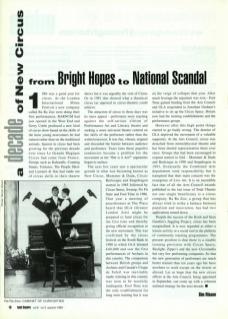1984 was a good year for circus. At the London International Mime Festival a new company called Ra-Ra Zoo were doing their first performances, Barnum had just opened in the West End and Gerry Cottle produced a new kind of circus show based on the skills of the keen young newcomers he had trained rather than on the traditional animals. Interest in circus had been growing for the previous decade ever since Le Grand Magique Circus had come from France. Groups such as Kaboodle, Cunning Stunts, Trickster, The People Show, and Lumiere & Son had made use of circus skills in their theatre shows but it was arguably the visit of Circus Oz in 1981 that showed what a theatrical circus (as opposed to circus-theatre) could achieve.
The attraction of circus in those days was its mass appeal – performers were reacting against the self-serious elitism of Performance Art and Literary theatre and seeking a more universal theatre centred on the skills of the performer rather than the writer/conceiver. It was fun, vibrant, original, and discarded the barrier between audience and performer. Years later these populist tendencies became a problem for the movement as the ‘But is it Art?’ arguments began to surface.
The next few years saw a spectacular growth in what was becoming known as New Circus. Mummer & Dada, Circus Burlesque and Snapdragon started in 1985, followed by Circus Senso, Swamp, NoFit State and Fool Time in 1986. That year a meeting of practitioners at The Place heard that GLA (Greater London Arts) might be prepared to fund circus for the first time and thereby give official recognition to the new movement. This was confirmed by the circus festival on the South Bank in 1988 to which GLA donated £40,000, and which saw the first performances of Archaos in this country. The comparison between British groups and Archaos and Canada's Cirque du Soleil was inevitably made; training in this country was seen to be woefully inadequate. Fool Time was the only establishment for long-term training but it was on the verge of collapse that year. After much leverage the argument was won – Fool Time gained funding from the Arts Council and GLA responded to Jonathan Graham's initiative to set up the Circus Space. Britain now had the training establishments and the performance groups.
However, after this high point things started to go badly wrong. The demise of GLA deprived the movement of a valuable supporter. At the Arts Council, circus was detached from mime / physical theatre and has been denied representation there ever since. Groups that had been encouraged to expand started to fold – Mummer & Dada and Burlesque in 1990 and Snapdragon in 1991. Eventually the Combined Arts department took responsibility but it transpired that their main concern was the resurgence of Live Art. It is an incredible fact that of all the Arts Council awards published in the last issue of Total Theatre not one single beneficiary is a circus company. Ra-Ra Zoo, a group that has always tried to strike a balance between populism and innovation, has had two applications turned down.
Despite the success of the Kosh and Sean Gandini's Juggling Project, circus has been marginalised. It is now regarded as either a leisure activity or a social tool in the plethora of community training programmes. The present position is that there is a sizeable training provision with Circus Space, Skylight, Zippos and the new Circomedia but very few performing companies. So that the new generation of performers are much better trained than ten years ago but have nowhere to work except on the streets or abroad. Let us hope that the new circus officer at the Arts Council, being appointed in September, can come up with a coherent national strategy for the next decade.

